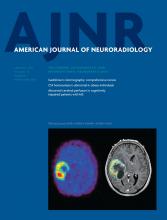Abstract
BACKGROUND AND PURPOSE: Patterns of DWI findings that predict recurrent ischemic events after TIA are well-established, but similar assessments of intracranial MRA findings are not available. We sought to determine the imaging characteristics of MRA that are predictive of early recurrent stroke/TIA in patients with TIA.
MATERIALS AND METHODS: We performed a retrospective analysis of 129 consecutive patients with a clinical diagnosis of TIA in whom MR imaging was done within 24 hours of symptom onset. We calculated the sensitivity, specificity, positive predictive value, and negative predictive value of >50% stenosis or occlusion of symptomatic intracranial arteries for recurrent stroke/TIA at 7 days after TIA. We used logistic regression analysis to adjust for the clinical ABCD2 score. We performed this analysis for symptomatic steno-occlusive lesions at any site and symptomatic steno-occlusive lesions on proximal large intracranial arteries (internal carotid artery, vertebral artery, basilar artery, and circle of Willis).
RESULTS: Forty-two (32.5%) patients had acute ischemic lesions on DWI; 16 (12.4%) had significant MRA lesions, of which 11 (8.5%) were on proximal vessels. Nine patients had early recurrence (TIA, 7; minor stroke, 2). Only patients with proximal MRA lesions were at higher risk of early recurrence independent of the ABCD2 score (adjusted odds ratio, 5.5; 95% confidence interval, 1.1–27.8; P = .04).
CONCLUSIONS: Proximal lesions of cerebral arteries seen on MRA were predictive of recurrent stroke/TIA at 7 days. These findings suggest that MRA could be used to improve the selection of patients with TIA at high risk of early recurrent stroke/TIA.
ABBREVIATIONS:
- ABCD2
- age, blood pressure, clinical deficit, duration, diabetes
- EKG
- electrocardiogram
- MIP
- maximum intensity projection
- TOF
- time of flight
- © 2013 by American Journal of Neuroradiology







